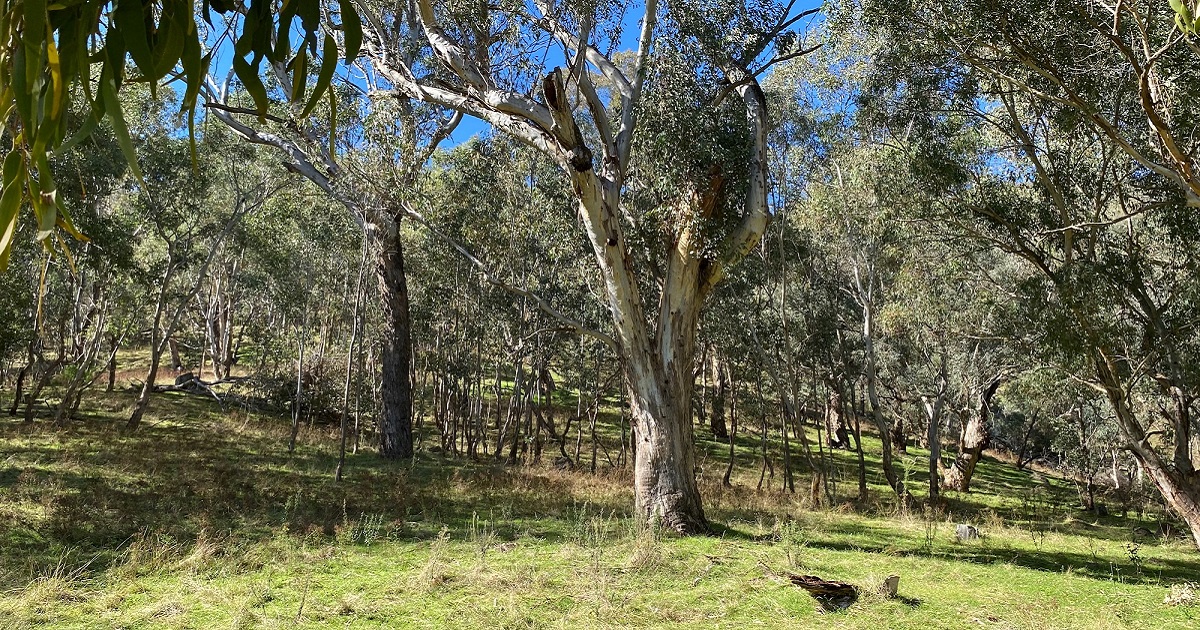Box Gum Grassy Woodland
Box Gum Grassy Woodland (BGGW) is an endangered vegetation type throughout NSW, and is critically endangered across eastern Australia.
Box gum grassy woodlands support more than 400 plant species with the highest diversity present in the grasses and forbs. The woodlands are primary habitat for a range of native fauna, including woodland birds such as the critically endangered Regent Honeyeater and Swift Parrot.
Box gum grassy woodland was once widespread across Southern Queensland, New South Wales, and Victoria. These woodlands have been extensively cleared for agriculture with remnant vegetation frequently in poor to moderate condition. Only about 5% of BGGW remains. Most remnants are found in private property.
What is Box Gum Grassy Woodland?
Box gum grassy woodland occurs on fertile soils and is characterised by a diversity of eucalypt trees, a sparse shrub layer, and a mix native tussock grasses and a high diversity of herbs.
The main canopy layer includes widely spaced eucalyptus trees such as White box (Eucalyptus albens), Yellow box (Eucalyptus melliodora), Apple box (Eucalyptus bridgesiana) and Blakely’s Red Gum (Eucalyptus blakelyi).

Why is Box Gum Grassy Woodland important?
These woodlands and derived grasslands (shrub/tree layer cleared) are important because they:
- are habitat for our significant flora and fauna
- support productive agriculture based on native pastures, and provide shade and shelter for stock
- are habitat for natural predators that can assist control of crop pests
- control erosion and dryland salinity and support nutrient/water cycling and soil formation.
A vast range of native plants and animals depend on BGGW as a habitat. Large older trees with hollows, woody debris, and connectivity to larger remnants are key features vital to species that are dependent on the woodland.
BGGW is also important for maintaining agricultural productivity. It plays a key role in controlling erosion & salinity, providing a wind break to stock, and managing invasive species.
BGGW remnants are important to Indigenous Australians. Many culturally significant artefacts remain in box gum woodlands. The preservation of this is vital and highly important to Indigenous communities.
Why are Box Gum Grassy Woodlands under threat?
BGGW was once widespread. However, the fertile footslopes and flats that support these woodlands were also the areas generally preferred for cropping, pasture and infrastructure development. As a consequence, box gum woodland has been reduced in area by 95% and remnants tend to be highly isolated and fragmented.
Box gum grassy woodland is threatened due to a range of impacts including fragmentation from clearing, degradation causing loss of understorey and loss associated important species (such as woodland birds), increased weeds from increased fertiliser/nutrient loads or disturbance, altered fire regimes, loss of canopy trees due to old age and lack of seedling recruitment.
What you can do to protect Box Gum Grassy Woodlands
- Manage stock to reduce grazing pressure in high-quality remnants (those with high flora diversity or fauna habitat).
- Encourage natural plant regeneration by fencing remnants, controlling stock grazing and undertaking supplementary planting, if necessary.
- Limit firewood from remnants (this includes living or standing dead trees and fallen material).
- Leave fallen timber on the ground.
- Undertake pest control of rabbits, hares, foxes, pigs and goats (using methods that do not disturb the native plants and animals of the remnant).
- Undertake weed control (taking care to spray or dig out only target species).
- Protect all sites from further clearing and disturbance.
- Ensure remnants remain connected or linked to each other; in cases where remnants have lost connective links, re-establish them by revegetating sites to act as stepping stones for fauna, and flora (pollen and seed dispersal).
Our Box Gum Grassy Woodland Projects
Riverina
Grants are available for assistance to improve and protect BGGW on properties over 10 hectares in the Riverina.
Find out more about the Riverina Box Gum Grassy Woodland project and apply for assistance.
Murray
Murray LLS has partnered with three local Landcare groups (Corowa District Landcare, Holbrook Landcare Network and West Hume Landcare) to support landholders to protect and enhance remnant grassy woodland vegetation and revegetate new areas on their properties to improve connectivity between patches of vegetation.
Find out more about the Grassy Woodland Project.
South East
The 3 year "Thinking inside the Box Gum Grassy Woodlands" project in the South East ran from 2019 - 2021 with follow-up studies completed in 2023.
This project aimed to address 3 key threats to BGGW:
- Threat 1: Loss of native ground layer plant species cover and diversity
- Threat 2: Lack of regeneration of shrubs and trees
- Threat 3: Habitat degradation due to incursion of exotic plants (naturalised and regionally significant weeds).
Read more about the outcomes of the Thinking inside the Box Gum Grassy Woodlands project.
Central Tablelands
Running from 2018 to 2023, the Driving Corridor Connectivity project in the Central Tablelands assisted private land managers to improve the condition, extent and connectivity of Box Gum Grassy Woodland communities.
A series of case studies and videos are available showcasing the on-ground works and successful outcomes of the Driving Corridor Connectivity Project.